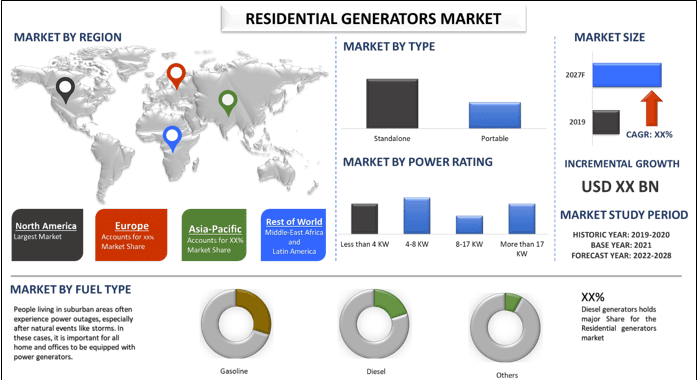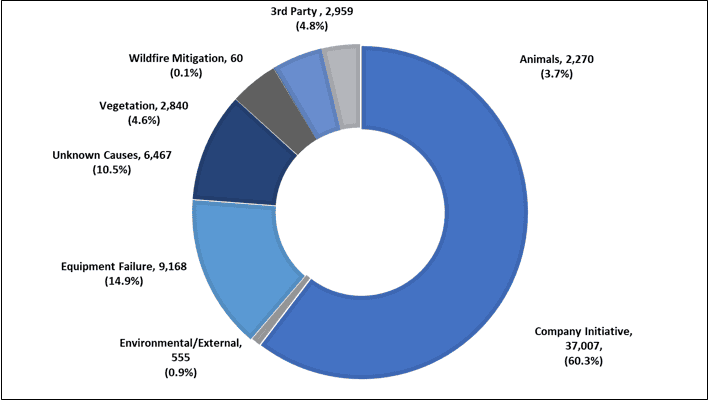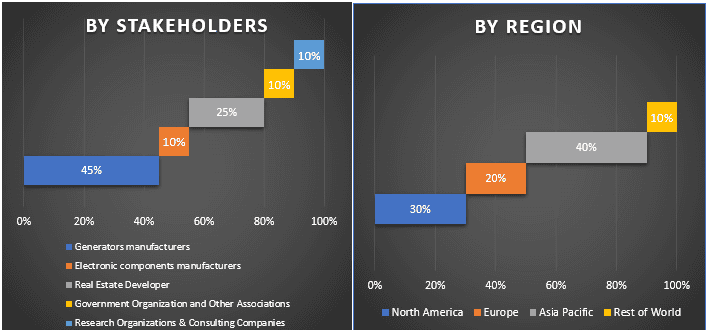- Home
- About Us
- Industry
- Services
- Reading
- Contact Us
Residential Generators Market: Current Analysis and Forecast (2021-2027)
Emphasis on Type (Stationary, Portable); Fuel Type (Gasoline, Diesel, Others); Power Rating (Less than 4 KW, 4-8 KW, 8-17 KW, More than 17 KW); Region/Country

Global Residential Generators Market was valued around US$ 9.5 billion in 2020 and is anticipated to display a CAGR of above 5% over the forecast period (2021-2027). Power generation through portable generators can be used only as an alternative to regular power supply form the utility companies. These can be used for temporary and emergency purposes only and cannot replace the power supply from DISCOMS (electricity distributor). Aging grid infrastructure is more vulnerable to power outages as electricity transmission and distribution infrastructure acts as a major backbone of the utility sector in any country/region. Growing number of power outages due to aging power infrastructure and environmental and external factor are the major factor driving the demand for power backup system for households. OEMs around the world are offering hybrid generators that are essentially internal combustion engines combined with a battery. These gensets provide power directly to the engine when the load is high, and the battery provides power when the load is less.
Causes of Power Outages by Pacific Gas and Electric Company (US)
Covid-19 pandemic has slowed the growth of the home power backup system market including residential generator, as countries around the globe were forced to implement lockdowns during the first half of 2020. Strict guidelines were issued by governments and local authorities to put all the non-essential operations to halt. This adversely affected the demand for portable generator.
Insights Presented in the Report
“Amongst type, standalone generators segment dominated the market in 2020.”
Based on type, the global residential generators market is segmented into Stationary and Portable. Currently standalone segment dominated the market. However, owing to growing disposable income and availability of low-cost portable generators for residential use would propel the growth of portable residential generators market during the forecast period.
“Amongst fuel type, Diesel residential generator dominated the market in 2020.”
Based on fuel type, the global residential generators market is divided into Gasoline, Diesel, Others. Currently Diesel residential generator dominates the market. However, owing to government focus on using alternative fuel sources gasoline and other fuel operated residential generators are expected to witness high growth during the analyzed period.
“Amongst power rating, 4 KW and 4-8 KW generators segment dominated the market in 2020.”
Based on power rating, the market is bifurcated into Less than 4 KW, 4-8 KW, 8-17 KW, More than 17 KW. In 2020, 4 KW, 4-8 KW segment dominated the market and is expected to maintain its dominance during the forecast period.
“North America represents as the largest market in the Global Residential Generators Market.”
For a better understanding of the market adoption of Residential Generators, the market is analyzed based on its worldwide presence in the countries such as North America (United States, Canada, Rest of North America), Europe (Germany, UK, France, Italy, Spain, and Rest of Europe), Asia-Pacific (China, Japan, India, Australia, and Rest of APAC), and Rest of World. North America constitutes the largest market for the industry and generated revenue of USD XX million in 2020. 68% of the Americans obtain their electricity through distribution systems managed by investor-owned utility companies. Some of the major players operating in the market include Cummins Inc., Eaton Corporation PLC, Atlas Copco AB, Briggs & Stratton Corporation, Caterpillar Inc., Generac Holdings Inc., Honda Motor Co Ltd, Kohler Co., Champion Power Equipment, Inc., Honeywell International, Inc., etc. Several M&A’s along with partnerships have been undertaken by these players to boost their presence in different regions.
Reasons to buy this report:
- The study includes market sizing and forecasting analysis validated by authenticated key industry experts
- The report presents a quick review of overall industry performance at one glance
- The report covers an in-depth analysis of prominent industry peers with a primary focus on key business financials, product portfolio, expansion strategies, and recent developments
- Detailed examination of drivers, restraints, key trends, and opportunities prevailing in the industry
- The study comprehensively covers the market across different segments
- Deep dive regional & country-level analysis of the industry
Customization Options:
The Global Residential Generators Market can further be customized as per the requirement or any other market segment. Besides this, UMI understands that you may have your own business needs, hence feel free to connect with us to get a report that completely suits your requirements.
Table of Content
Analyzing the historical market, estimation of the current market, and forecasting the future of the Global Residential Generators were the three major steps undertaken to create and analyze the adoption of Residential Generators across the globe. Exhaustive secondary research was conducted to collect the historical market numbers and estimate the current market size. Secondly, to validate these insights, numerous findings and assumptions were taken into consideration. Moreover, exhaustive primary interviews were also conducted, with industry experts across the value chain of the industry. Post assumption and validation of market numbers through primary interviews, we employed a bottom-up approach to forecast the complete market size. Thereafter, market breakdown and data triangulation methods were adopted to estimate and analyze the market size of segments and sub-segments the industry pertains to. Detailed methodology is explained below:
Analysis of Historical Market Size
Step 1: In-Depth Study of Secondary Sources:
Detailed secondary study was conducted to obtain the historical market size of the Residential Generators through company internal sources such as annual report & financial statements, performance presentations, press releases, etc., and external sources including journals, news & articles, government publications, competitor publications, sector reports, third-party database, and other credible publications.
Step 2: Market Segmentation:
After obtaining the historical market size of the Residential Generators, we conducted a detailed secondary analysis to gather historical market insights and share for different segments & sub-segments for major regions. Major segments included in the report are type, fuel type, power rating. Further regional & country-level analyses were conducted to evaluate the overall adoption of the Residential Generators in the global context.
Step 3: Factor Analysis:
After acquiring the historical market size of different segments and sub-segments, we conducted a detailed factor analysis to estimate the current market size of Residential Generators. Further, we conducted factor analysis using dependent and independent variables such as growing residential establishments and growing number of power outrages etc. Historical trends and their year-on-year impact on the market size and share was analyzed. Demand and supply side scenario was also thoroughly studied.
Current Market Size Estimate & Forecast
Current Market Sizing: Based on actionable insights from the above 3 steps, we arrived at the current market size, key players in the Market, and market shares of the segments and company. All the required percentage split, and market breakdowns were determined using the above-mentioned secondary approach and were verified through primary interviews.
Estimation & Forecasting: For market estimation and forecast, weights were assigned to different factors including drivers & trends, restraints, and opportunities available for the stakeholders. After analyzing these factors, relevant forecasting techniques i.e., bottom-up approach was applied to arrive at the market forecast to 2027 for different segments and subsegments across the major regions globally. The research methodology adopted to estimate the market size encompasses:
- The industry’s market size, in terms of value (US$) and the adoption rate of Residential Generators across the major markets
- All percentage shares, splits, and breakdowns of market segments and sub-segments
- Key players in the Residential Generators Market in terms of services offered. Also, the growth strategies adopted by these players to compete in the fast-growing market.
Market Size and Share Validation
Primary Research: In-depth interviews were conducted with the Key Opinion Leaders (KOLs) including Top Level Executives (CXO/VPs, Sales Head, Marketing Head, Operational Head, and Regional Head, Country Head, etc.) across major countries. Primary research findings were then summarized, and statistical analysis was performed to prove the stated hypothesis. Inputs from primary research were consolidated with secondary findings, hence turning information into actionable insights.
Split of Primary Participants in Different Regions
Market Engineering
Data triangulation technique was employed to complete the overall market estimation and to arrive at precise statistical numbers of each segment and sub-segment of the Residential Generators Market. Data was split into several segments & sub-segments post studying various parameters and trends in the areas of type, fuel type, power rating.
The main objective of the Residential Generators Market Study
The current & future market trends of Residential Generators were pinpointed in the study. Investors can gain strategic insights to base their discretion for investments from the qualitative and quantitative analysis performed in the study. Current and future market trends would determine the overall attractiveness of the market at a regional & country level, providing a platform for the industrial participant to exploit the untapped market to benefit as a first-mover advantage. Other quantitative goals of the studies include:
- Analyze the current and forecast market size of Residential Generators in terms of value (US$). Also, analyze the current and forecast market size of different segments and sub-segments
- Segments in the study include areas of type, fuel type, power rating
- Detailed analysis of the regulatory framework for the Global Residential Generators industry
- Analyze the value chain involved with the presence of various intermediaries, along with analyzing customer and competitor behaviors of the industry
- Analyze the current and forecast market size of the Residential Generators for the major regions & countries
- Major regions studied in the report include North America (US, Canada, Rest of North America), Europe (Germany, United Kingdom, France, Italy, Spain, Rest of Europe), Asia Pacific (China, Japan, India, Australia, Rest of Asia-Pacific), and Rest of World
- Company profiles of the Residential Generators Market players and the growth strategies adopted by them to sustain in the fast-growing market
Deep dive regional & country level analysis of the industry
Related Reports
Customers who bought this item also bought










